19 Types of Wine Glasses to Boost Your Enjoyment & Sophistication
Author: Rick Worst | Editor: Omar Alonso
Review & Research: Jen Worst & Chris Miller

For all the types of wine glasses, there are equally as many people that say, “beer is made by man, wine by God”. Maybe a glass of fine wine will do the trick. In our increasingly stressed lives, a glass of wine at the end of the day is all the relaxation we seek.
For every activity, you need the right apparatus. That is particularly true for activities that are supposed to help us take it easy. And it's no different in wine country.
We all know there are a ton of different wines out there but not many know that there are a lot of different kinds of wine glasses too. And getting to know them so that your evening sits just right is kind of exciting.
We weren't kidding when we said there are more than a few types of wine glasses. Depending on whether you have red or white wine, the preference of a glass changes. Sometimes it also depends on the specific type of wine.
Let's break it down without further ado. If you think you'll enjoy this, go ahead and open and look at the 35 types of drinking glasses, too. There's so much awesome stuff out there, many, like the glasses below, designed to be used to drink specific types of wine and compliment and even enhance their tastes.
Red Wine Glasses
If you are drinking red wine, you need a large glass with a full and round bowl and a large opening. The full bowl allows the aroma and flavors to come in contact with the air. This increases the rate of oxidation and smooths the flavors. And the opening lets you dip your nose and smell the wine.
Standard Red Wine Glass
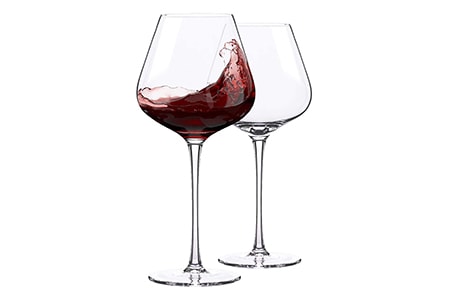
This is perfect for medium to full-bodied red wines with or without spicy components. That would be like Zinfandel, Shiraz, Carignan, Merlot, Chianti, or Malbec.
This glass has a small opening so that the flavors meet the tongue in a continuous flow. It softens the spiciness and the flavors which is the goal.
Obviously these wine glass names are associated with the type of wine they're designed to be used with, which makes things easier for all of us.
Cabernet Wine Glass
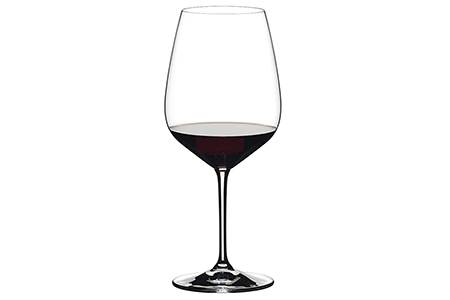
This wine glass is tall and is great for Cabernet Sauvignon and other bold wines. It mostly has a broad bowl that lets the wine breathe and a really narrow rim that accumulates the wine. The glass truly serves the purpose of enhancing the aroma of the wine.
The less you pour into the glass, the more fragrant the wine becomes. It is the perfect way to consume wine if you're into the olfactory experience of it.
Burgundy Wine Glass
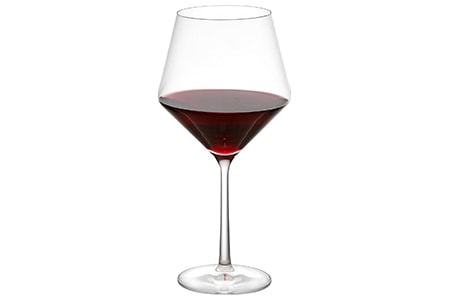
This one is for lighter and more delicate reds like Pinot Noir, Italian Barolo, and Barbaresco. You can even try Beaujolais, red Burgundy, and Dolcetto in these big bowls. It enhances the acidity and intensity of full-bodied wines.
The bowl itself is broader than Bordeaux glass and has a relatively narrower top which sends the wine right to the tip of the tongue. You can detect the nuances of the wine’s flavor when you pour it into a beautiful Burgundy wine glass.
Rosé Wine Glass

Similar to tulip glasses for champagne with their thin stems that are long and elegant, widening in the middle of the bowl and narrowing at the opening, they are designed with some peculiar differences.
The diamond shape at the midpoint is meant to create more of a surface area for evaporation so the fruit and floral aromas are more prominent, as is the silkiness as it pours into the mouth. These are the newest types of wine glasses, created by experts over a 4 week period.
Bordeaux Wine Glass
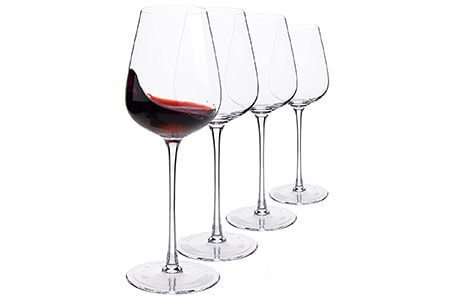
The Bordeaux wine glass is suitable for full-bodied and heavier red wines like Bordeaux blends, Petite Sirah, Cabernet Sauvignon, Cabernet Franc, Malbec, or an Alicante Bouschet.
These wines have high tannins and you’d want to get a Bordeaux wine glass for them. If you didn’t know it already, tannins contribute to the bitterness of wine.
This is the tallest wine glass but it also has a broad opening, not as much as others but broad nevertheless. The height of the glass helps keep a good distance between the wine and your mouth.
This means the ethanol is allowed to reach your nose. It allows more oxygen which softens the tannins. It minimizes the bitterness of the wine and maximizes the flavor. The large bowl also allows younger wines to breathe.
Zinfandel Wine Glass
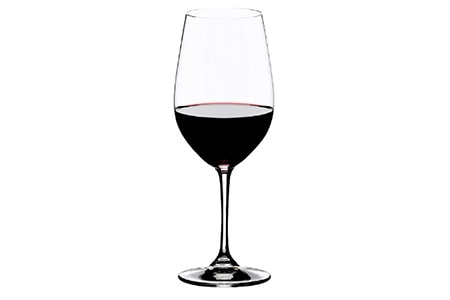
This one is smaller than the Cabernet and Bordeaux wine glasses. The shape is such that it brings out the nuances in the wine’s berry and spice.
It has a thin rim that transports the wine right to the middle of your tongue so that you can experience the tannins, acidity, and fruity flavors of the wine.
Pinot Noir Wine Glass
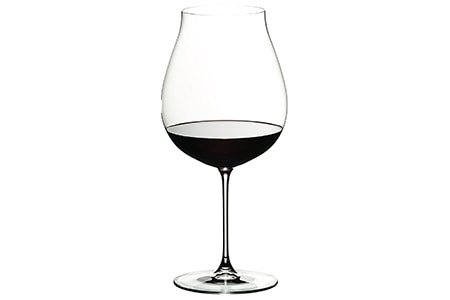
If you like Pinot Noir or any other light red wine, you might want to pick this glass or a Burgundy wine glass. It has a wide bowl that allows the wine to get in touch with a lot of air and adds to the flavor and aroma.
The lip of the glass is turned-out and flared so that it takes the fruity sweet and crisp wine to the front of your palate. It’s one of those glasses that is meant for you to swirl the wine and enjoy its taste and aromas. It’s a great tool to show off your skills at a wine tasting.
White Wine Glasses
White wines are in a league of their own. They need to be poured into types of wine glasses that are more U-shaped and upright when compared to a red wine glass.
The bowl needs to be smaller compared to red wine glasses so that it can preserve the smell and maintain the wine’s cool temperature. Plus they look sophisticated when you're staging a dining room.
Sauvignon Blanc Glass
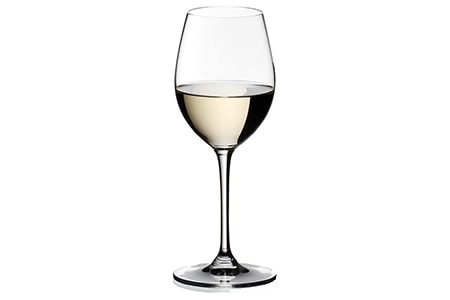
One of the popular wines, Sauvignon Blanc is a light to medium-bodied wine. It's fruity and floral like the white Bordeaux, Fume blanc, Loire, Vinho Verde, Chenin blanc, Muscadet, Muscat blanc and Pinot grigio.
The glass itself is tall and quite slender. It's perfect to capture the details of a delicate floral and fruity aroma of white wine.
This glass is made such that the aroma goes straight to your nose and when you drink it, the acidity of the wine goes to the sides of your mouth. Well, they get most of it.
Interestingly, the glass also causes the tongue to form a U-shape. This takes the wine to the front part of the middle of your palate and makes the sip smoother.
Montrachet Glass
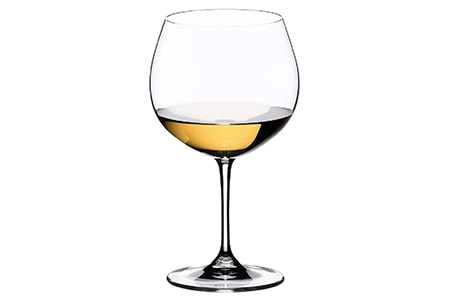
The Montrachet glass is great for white wine like Montrachet, white Burgundy, Corton-Charlemagne, and Meursault which have complex flavors.
It has a large bowl that allows those complexities to interact. And when the air hits them, they open up. Nice glasses like this go well with fancy kitchen styles like french country designs rather than a decor like a cottage kitchen.
The rim is quite large too and allows you to smell the mix of aromas and takes the wine to the edge of your tongue. Either side of the palate will feel sour and sense the acidic spectrum of the wine.
Chardonnay Wine Glass
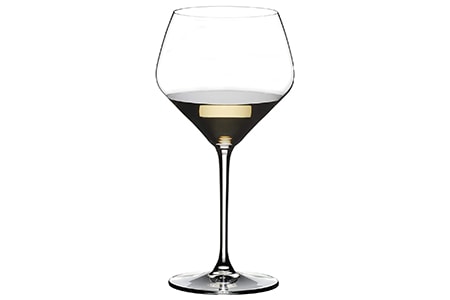
This is another glass for those full-bodied wines like Semillon and Viognier. The rim is large and it allows the wine to reach the tip and sides of your tongue.
When you do it right, you will feel the sweetness of the wine. The bowl is just large enough to let the right amount of air in and help concentrate the aroma.
Riesling Sweet & Standard Sweet Wine Glass
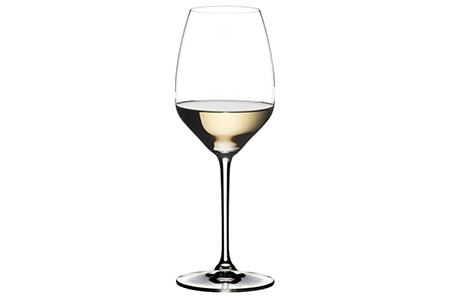
This one is for the sweet wine varieties like Zinfandel, Sauvignon blanc, and Gruner Veltliner. The glass in itself is a bit small when compared to others and has a smaller rim.
It guides the wine towards the center and the back of your mouth. The idea is to keep you from getting overwhelmed by the sweetness of the wine.
Sparkling Wine Glasses
These types of wine glasses are created specifically for sparkling wine, known as champagne. They each achieve a different goal and you can choose based on which makes the most sense for your palate.
Tulip Wine Glass
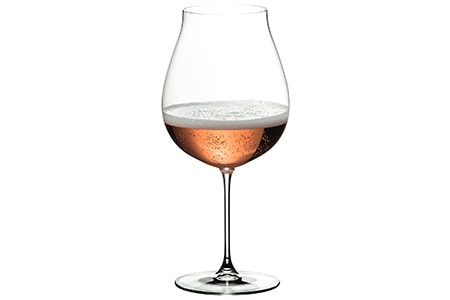
Champagne is often served in a tulip glass, which features a wide, flared body which then recedes and again flares out towards the mouth. This allows the drinker to experience more of the aroma than a flute glass allows, at the sacrifice of a faster loss of carbonation.
Coupe Wine Glass
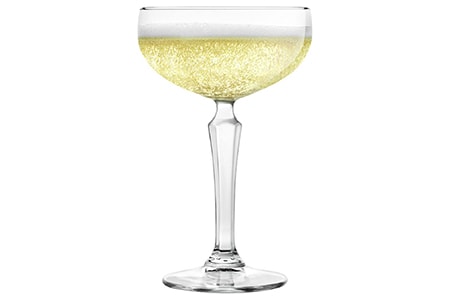
The champagne coupe is a short glass with a broad bowl, all seated atop a saucer foot. They generally will hold between 6 to 8 fluid ounces of liquid. You'll often find restaurants serving cocktails in these since they're less likely to spill.
Flute Wine Glass
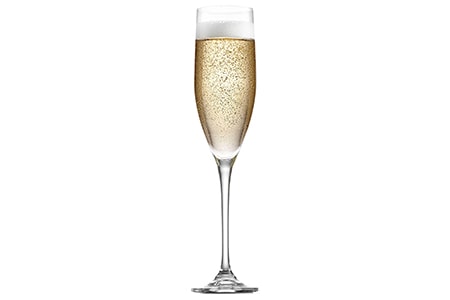
The champagne flute features a long stem atop which sits a thin, conical, elongated bowl. This slender bowl is what gives it the name of a flute, due to the appearance. This glass came about in the early 1700's alongside other wine stemware once glass became the material of choice.
The tapering of the bowl inward helps retain the carbonation of the champagne by keeping the surface area against the air as small as possible. The height emphasizes the rise of the bubbles and is purely for aesthetics. These are the coolest of the wine glasses types, I think.
Dessert Wine Glasses
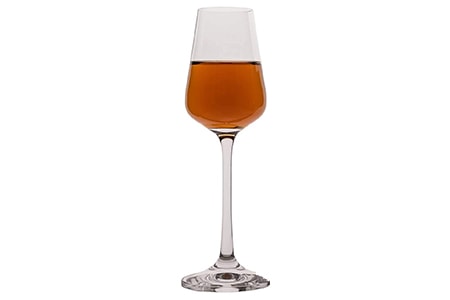
The last category of wines (and their glasses, for now) is the dessert wine. These are best served in a smaller glass because of the high alcohol content in the wines that suit them.
These glasses are meant to send the wine to the back of your mouth so that you can detect the sweetness in the wine. If you get a port wine glass–tall glass and narrow mouth–or a sherry wine glass which is small and pair it with strawberries, you really have a great dessert in front of you.
Additional Types of Wine Glasses
There are some wine glasses that either serve multiple purposes or don't fit neatly into one of the above categories, but you should still know about them. Let's look at those now.
Port Wine Glasses
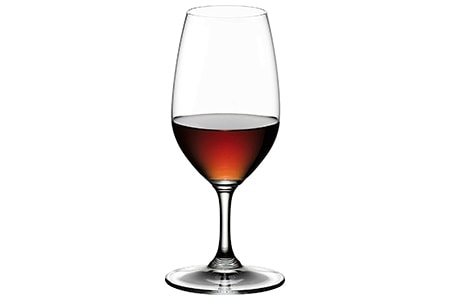
Port wine glass styles are on the smaller side, not only in height but in the size of the cup. The moderately long stem sits atop a saucer foot and leads to a bowl that can vary between tulip shapes to straight edged.
You're meant to hold the glass by the bowl itself so the heat from your hand helps lift up the aromatics from the fortified wines you drink from them. The size also helps with portion control since these port wines are more potent than regular wine.
Stemless Wine Glasses
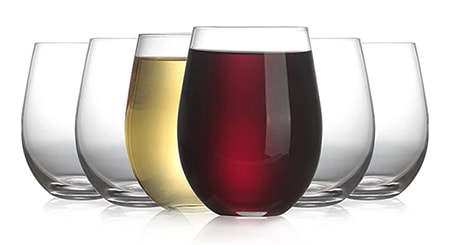
A stemless glass is very much like a pint glass except with a concave bottom sometimes leading to a saucer (and more often not, so be careful about tipping them over). Many often hold a greater volume of liquid for the at-home enjoyer.
They contain the benefits of most fancier wine glasses while also lowering the center of gravity, which should help them not tip over as easily, in theory.
Balloon Wine Glasses
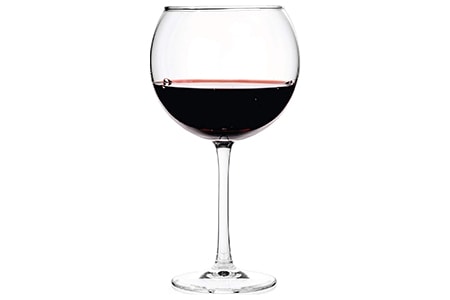
The balloon wine glass shape has a very broad mid-point that maximizes the surface area of the liquid to the air, but then tapers to a thinner opening. This allows the red wine to breathe more readily while concentrating the aroma to your nose when you tip the glass.
The name comes from the shape, and they typically hold around 12 ounces of wine, where a normal pour is 5 to 6 ounces. This gives a maximum air exposure in the middle of the cup.
Sherry Wine Glasses
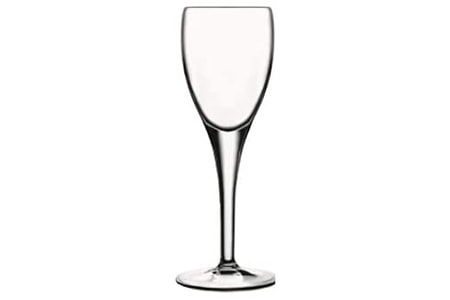
The sherry glass holds a dry, fortified wine known as sherry that boasts a high alcohol percentage, and thus the sherry glass is more akin to a whisky glass, holding about three ounces of liquid.
The glass tapers down from the already narrow opening to the stem, which is often decorative before meeting a stable saucer at the foot.
Aerating Wine Glasses
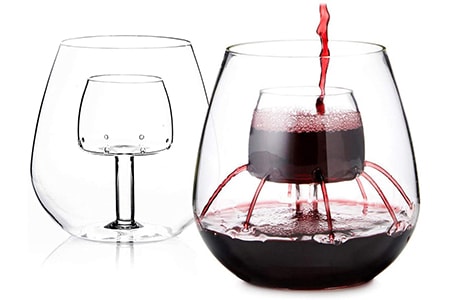
To really maximize the breathing of your wine, you can opt for an aerating glass that seeks to maximize as much of the liquids surface area with the air as possible, often by sloshing, trickling, and otherwise stirring the wine similar to a decanter. These are kind of novelty items and not to be taken too seriously.
The Wine Glass Basics
Every wine glass has four parts called the base, stem, bowl and the rim. The base is what makes the glass stable, the step gives you something to hold on to and keeps your fingerprints off the bowl which is above the stem.
The first detail to remember is that a wine glass bowl is the most important component. It needs to be large enough for you to swirl the wine.
It must also be such that the aroma of the wine does not escape the glass. You will see the value of it when you get a full-bodied red wine that needs space to breathe.
White wines, on the other hand, do just fine in smaller and relatively narrower U-shaped glasses. This helps maintain the cooler temperature of the white wine.
The uppermost part of the bowl is called the rim. Thinner rims make it easy for you to drink out of a glass while thicker rims draw too much attention to themselves because of how inconvenient they are.
That is why a lot of people find the same kind of wine tasting better in a restaurant. You could credit the food you paired it with but sometimes it does all come down to the lovely glass. People care about their wine glass shapes like coffee drinkers do with their types of coffee makers.
Wine Glass Types for Every Wine
You don’t have to buy a bunch of these different types of wine glasses just because you like various types of wine. You can get those universal glasses that don’t take up the shelf space but also keep the integrity of your wine intact.
And maybe in time, you can expand the collection, instead of going all out at once. This gives you time to become more intimate and experienced as time passes instead of being overwhelmed. Take your time with the different types of wine glasses!



